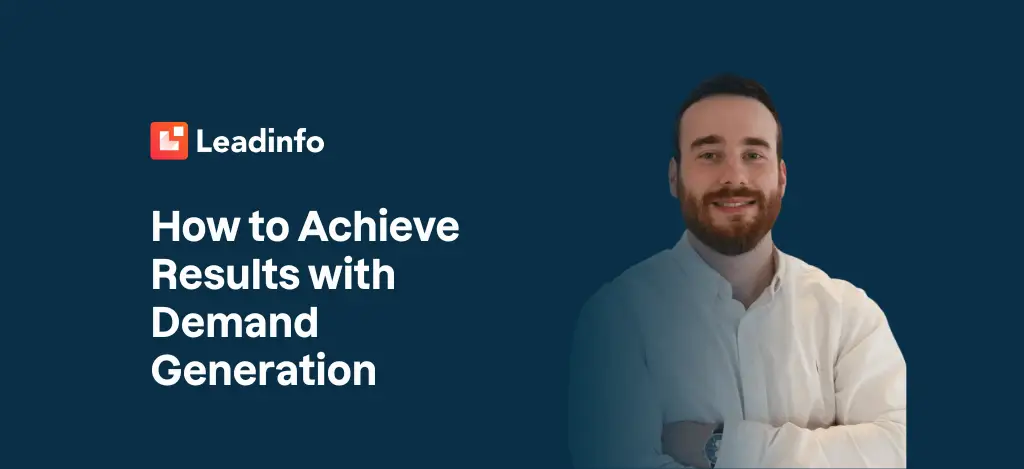✨ Want to rewatch the full recording? You can find it here: Webinar: How to Achieve Results with Demand Generation (Leadinfo x Leadgate) The webinar is recorded in Dutch, but you can use the subtitle feature to transcribe the webinar to English or other languages.
What is Demand Generation exactly?
Ask ten marketers what Demand Generation is, and you will likely get ten different answers. Renzo mentions a fitting example: “Nobody fully agrees.”
At Leadgate, they use a clear definition:
👉 Turning your target audience into fans of your company through online marketing – without directly pushing for sales.
The goal is not to generate leads right away, but to build interest and trust with the 97% of your audience that is not yet actively searching for your product or service.
Why Demand Generation is more relevant than ever
The traditional focus on lead generation is under pressure:
- Rising cost per lead: campaigns are getting more expensive.
- Leads often not ready to buy: sales receives “good profiles” that are not yet interested in purchasing.
- Audiences are lead-weary: most people now know the game of gated content and sales follow-ups.
At the same time, we see a shift in buying behaviour:
- New generations prefer to take control of their own research (McKinsey & Gartner).
- Buyer journeys are becoming longer and more complex, with an average of 9 touchpoints and a decision time of 36 days.
In short: if you want to achieve results with Demand Generation, you need to look beyond the 3% of your market that is ready to buy today.
The Demand Generation pyramid
Leadgate divides the market into a pyramid:
- 60% – not yet aware of a problem.
- 20% – problem aware, but not yet looking for a solution.
- 17% – actively researching solutions.
- 3% – in market, ready to buy.
Traditional lead generation campaigns mainly target that 3%. With Demand Generation, you also address the other 97%, so you are top of mind once they are ready.
How to achieve results with Demand Generation
Renzo describes an approach in three phases, based on the See–Think–Do model:
- See phase – Visibility & brand awareness
- Goal: create first touchpoints.
- Content: brand movie, blogs, short awareness videos.
- KPIs: view rate, click-through rate.
- Think phase – Creating & nurturing demand
- Goal: make your audience aware of their problem and your solution.
- Content: whitepapers, explainer videos.
- KPIs: completion rate, time on page.
- Do phase – Conversion & leads
- Goal: activate a warmed-up audience.
- Content: on-demand webinars, demo requests.
- KPIs: conversion rate, engagement.
Key insight: each phase has its own KPIs. It is unrealistic to measure Demand Generation on cost per lead.
Making it measurable
A common challenge: how to prove results with Demand Generation, even in the short term? In the webinar, Leadgate shares practical ways:
- Measure engagement on LinkedIn: likes, comments and clicks show interest early on.
- Use Leadinfo segments: monitor companies that visit your site via multiple channels (e.g. Google Ads and LinkedIn Ads).
- Company Page Insights: track which industries are visiting your LinkedIn page after campaigns.
- Branded searches in Google Search Console: an increase in searches for your company name = rising brand awareness.
This way you can show stakeholders within weeks that your approach is working – even if the first leads only come in later.
Tips from Leadgate’s practice
- Start with a broad audience (at least 50,000 people).
- Build retargeting audiences in LinkedIn to refine per phase.
- Test different content types (video, blogs, whitepapers) to avoid ad fatigue.
- Use A/B testing to optimise KPIs at each stage.
Conclusion: from leads to long-term results
The webinar makes it clear: traditional lead generation is too limited. By combining Demand Generation with lead generation:
- You reach the 97% that is not yet ready to buy.
- You build sustainable brand preference.
- And you prove, with the right KPIs and tools, that your marketing efforts deliver results.
With Demand Generation, you are not just generating leads – you are creating lasting growth and real results.
Leadinfo was an indispensable part of this case. Want to try it yourself? You can test Leadinfo free for 14 days, with no strings attached. Click here to create an account.


